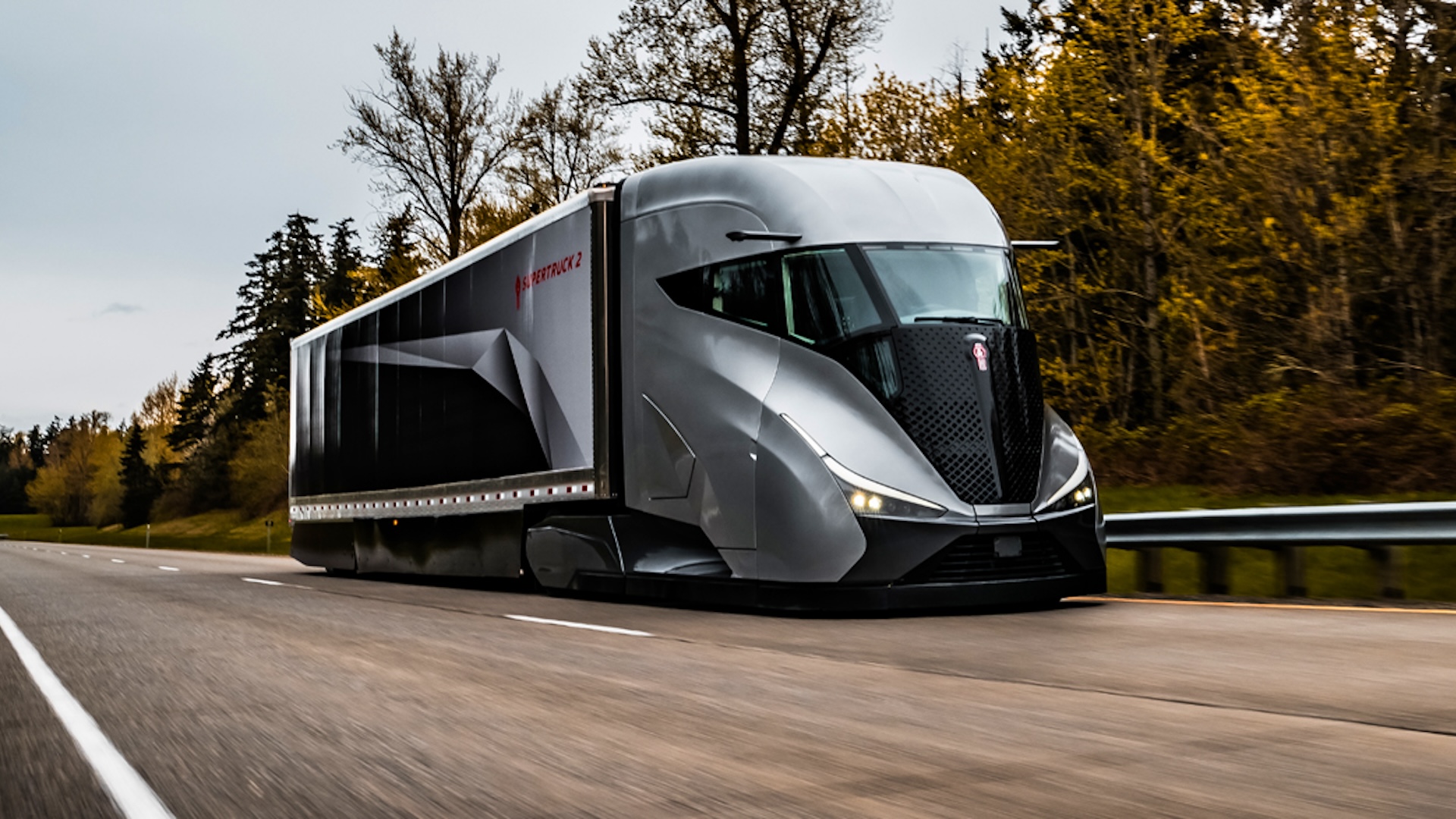

“Build it, and they will come.” But what if they had no money? Well, if what they want to build is a future-proofed big rig, the U.S. Department of Energy (DOE) can help pay for that. What’s the catch? Improved aerodynamics, improved efficiency, fuel savings, and cleaner air—those are the things Kenworth’s wild-looking SuperTruck 2 concept sets out to achieve.
After six years of development, the Kenworth SuperTruck 2 prototype was unveiled at this week’s ACT Expo in Las Vegas. And if Batman owned a heavy-duty semi-tractor, it’d probably look like this. Feigning the traditional tractor snout, the Kenworth SuperTruck 2 resembles a motorcycle helmet no doubt for aerodynamics but with a dash of intimidation. Beyond its look, the big rig concept is powered by a hybrid diesel powertrain that combines a 440-horsepower PACCAR MX-11 engine with a 48-volt electric generator. With added energy waste recovery, a bench test returned an engine efficiency figure of 55.7%. A 12-speed automatic transmission completes the drivetrain.

The SuperTruck 2 prototype weighs 7,000 pounds less than its benchmark, the 2009 Kenworth T660. At the time, the T660 was considered one of the most fuel-efficient trucks with an estimated 6 mpg, though some managed 7 mpg. Doesn’t sound like much, but when you’re traveling 125,000 miles a year, the fuel savings also translate into five figures. Kenworth reports 12.8 mpg with its hybrid concept, including an overall efficiency jump of 136%. With the SuperTruck 2, there’s potential for more gas money saved (and perhaps spent on the drivers instead).
Kenworth didn’t just create a fuel-sipping semi. It designed a driver-oriented one, too. With a narrower face and a large, curved windshield, visibility is expansive. The outside mirrors were removed to minimize drag but were replaced with a camera system that encompasses rearview monitoring, trailer tracking, and night vision enhancements.

More comfort-focused upgrades include a redesigned adjustable sleeper berth. The bed folds over the sofa, which creates separate sleeping and sitting areas. The tabletop can also rotate based on your needs: working, eating, or relaxing. After a long drive, getting in and out of the truck is less of a chore too. Ingress and egress are made easier thanks to a large driver-side door opening and extendable stair-like steps.
Kenworth admits that diesel isn’t exactly the future of fueling but notes that its SuperTruck 2 is built to accommodate whatever the future does bring. The company says the overall layout is flexible—no need to change the basic cabin design. SuperTruck 2 can be configured to support zero and near-zero emission solutions, including fuel cells, hydrogen tanks, natural gas tanks, and batteries.

With a name taken straight out of a ’90s cartoon, the DOE’s SuperTruck program began in 2009. Its goal was to encourage efficiency improvements for Class 8 heavy-duty trucks. That means vehicles weighing more than 33,000 pounds including everything from cement mixers, fire trucks, and tour buses to large semis.
Cummins-Peterbilt, Daimler, Navistar, and Volvo signed up at the onset of the program and each saw freight efficiency improvements, many of which exceeded the DOE’s goal of a 50% overall efficiency increase. The added funding helped the truck manufacturers develop advancements beyond just the engine and powertrain but also improvements in tires, materials, and energy management. Daimler showcased a 115% freight efficiency increase during a five-day, 312-mile road trip. Volvo’s testing produced an 88% improvement over a customer drive-cycle.

With its success, more federal funding opportunities became available, with each round seeing an increase in the shared pot. In 2016, SuperTruck 2 provided $80 million to four recipients, and we covered Navistar International’s prototype hybrid semi last year.
The DOE announced SuperTruck 3 in 2021 and offered up $127 million for five recipients. The latest fund, SuperTruck: Charged, is earmarked for $72 million for a yet-to-be-determined number of charging infrastructure projects. Although still prototypes and concept models, the vehicles developed through the SuperTruck initiative aren’t merely science fair show-and-tell demos. It’s good to see these projects go the distance, as many of the technologies, designs, and materials have already made their way into production.
